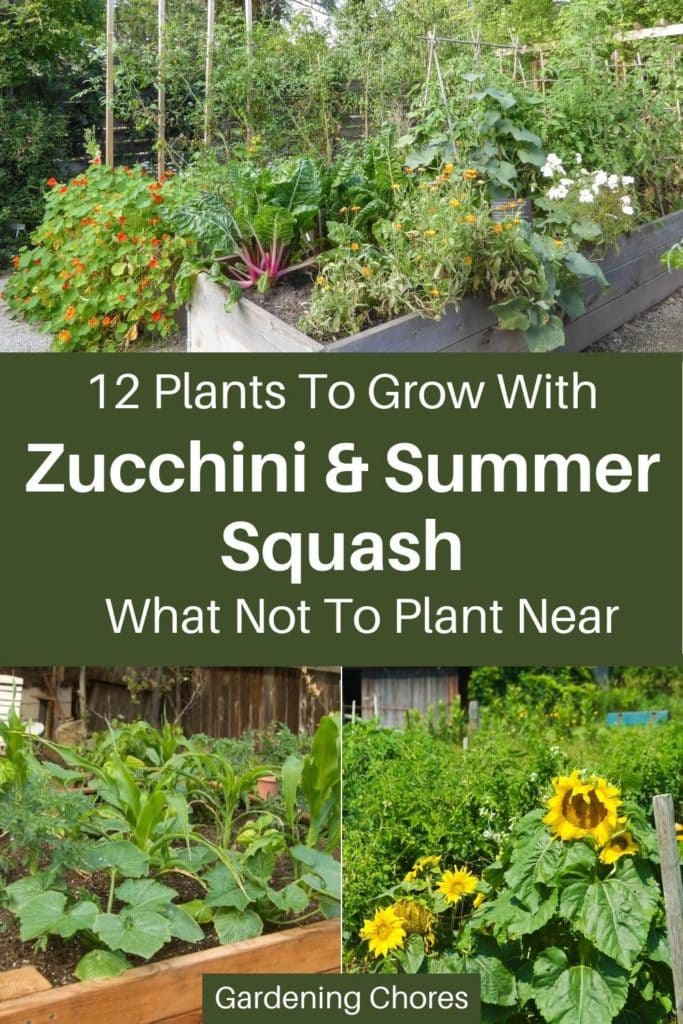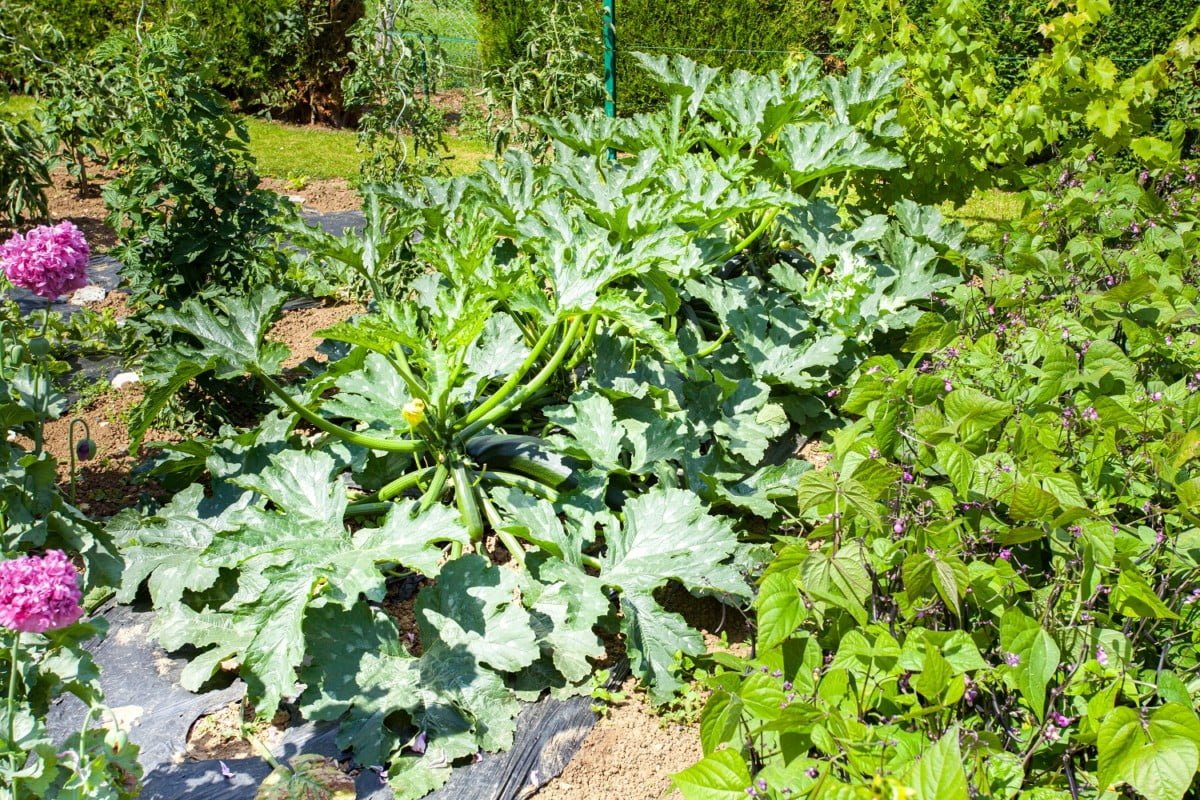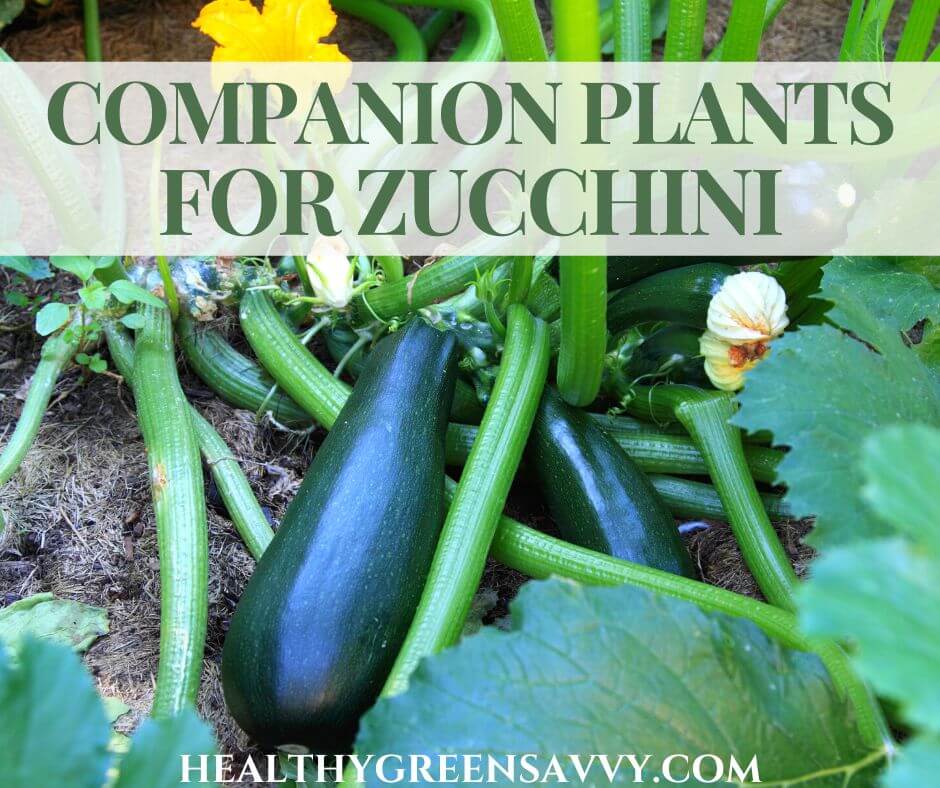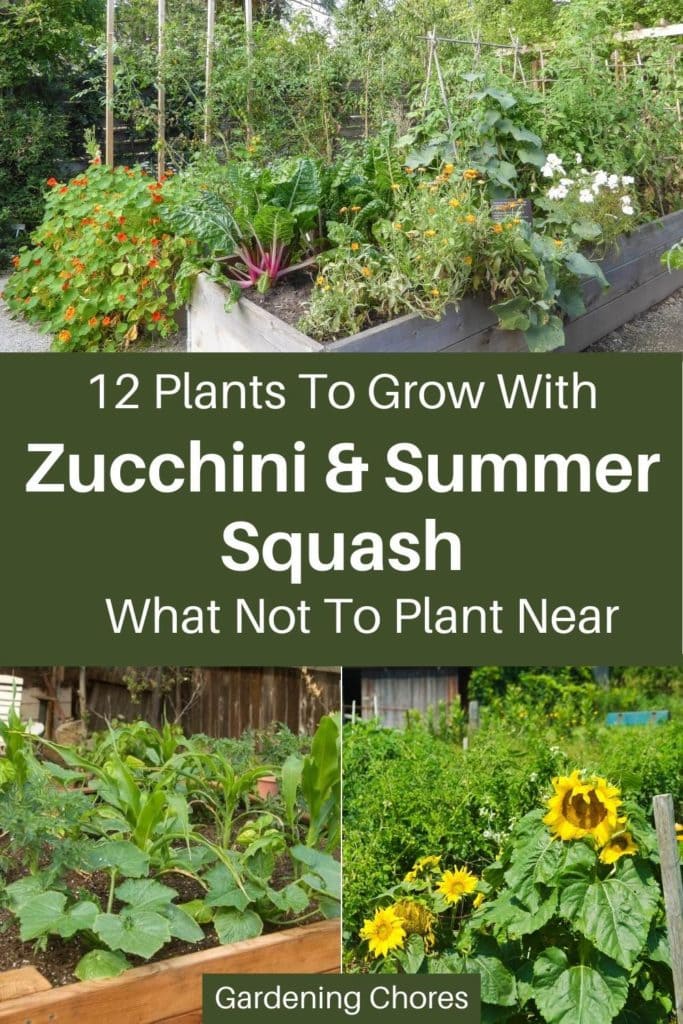Imagine having a vibrant zucchini garden, brimming with plump and juicy fruits just waiting to be harvested. To ensure the success of your zucchini plants, it is crucial to carefully consider their companions. Some plants may hinder the growth and health of your zucchini, resulting in a less bountiful harvest. In this article, we will explore seven plants that should be avoided when planting near your precious zucchini. So, let’s discover the undesirable neighbors that could potentially hinder the thriving growth of this beloved vegetable.

Tomato
Why tomatoes and zucchinis should not be planted together
A friendly reminder for all the garden enthusiasts out there: when it comes to planting your zucchinis, it’s best to keep them away from tomatoes. The reasons behind this are primarily concerned with the health and growth of both plants. In this article, we will explore why tomatoes and zucchinis should not be planted together, highlighting the competition for nutrients, the risk of diseases, and their incompatible growth habits.
Competition for nutrients
One of the main reasons why tomatoes and zucchinis should not be planted together is the competition for nutrients. Both plants have a voracious appetite for nutrients, especially when they are in the growing stages. When planted side by side, they tend to struggle for the limited resources available in the soil. This competition can lead to stunted growth and decreased productivity for both plants, as they continuously vie for essential elements like nitrogen, potassium, and phosphorus.
Risk of diseases
Another crucial aspect to consider is the risk of diseases that can occur when tomatoes and zucchinis are planted together. Certain diseases, such as bacterial wilt, can affect both plants and easily spread between them if they are closely situated. This puts both your tomatoes and zucchinis at a higher risk of infection and could potentially lead to an overall decline in the health and productivity of your garden.
Incompatible growth habits
Lastly, tomatoes and zucchinis have incompatible growth habits that can hinder each other’s development. Tomatoes tend to grow tall and require sturdy support structures, such as cages or trellises, to keep them upright. On the other hand, zucchinis tend to sprawl and take up more horizontal space. When planted together, the sprawling nature of zucchinis can overshadow and overtake the space needed for the upward growth of tomatoes. This can result in tomato plants being overshadowed and not receiving sufficient sunlight, leading to weaker and less fruitful vines.
Potato
Allelopathic effects
Let’s focus our attention on potatoes now and why they should be kept away from zucchinis in your garden. One important factor to consider is the allelopathic effects that potatoes can have on zucchinis. Allelopathy refers to the ability of certain plants to release chemicals that can inhibit the growth or development of neighboring plants. Potatoes, in particular, are known to release allelochemicals that can suppress the growth of zucchinis, compromising their overall health and productivity.
Potential for disease transmission
Potatoes also pose a risk when planted near zucchinis due to their potential for disease transmission. Both plants are susceptible to various fungal and bacterial diseases, such as late blight or powdery mildew. When planted together, these diseases can easily spread between the two plants, making it more challenging to control and eliminate them. It is advisable to keep a distance between potatoes and zucchinis to minimize the risk of cross-contamination and maintain the health of both plants.
Competition for nutrients
Similar to tomatoes, potatoes are also heavy feeders and have high nutrient requirements. When planted in close proximity to zucchinis, they can intensify the competition for nutrients in the soil. Zucchinis, which are relatively fast-growing plants, may suffer from nutrient deficiencies if they have to contend with the nutrient demands of potatoes. This can result in stunted growth or decreased yields for your zucchinis.
Invasive tendencies
Lastly, potatoes are notorious for their invasive tendencies. They have a tendency to spread aggressively through their underground tubers. In this regard, planting them near zucchinis can lead to overcrowding issues and interfere with the growth of your zucchinis. To ensure optimal growth and productivity for both plants, it is recommended to provide ample spacing and separate these two crops in your garden.

Cucumber
Shared susceptibility to powdery mildew
Moving on to cucumbers, it is important to note that they share a common susceptibility to powdery mildew with zucchinis. Powdery mildew is a fungal disease that can thrive in warm and humid environments, common in many gardens. When cucumbers and zucchinis are planted in close proximity, the chances of powdery mildew spreading between the two plants increase significantly. It is advisable to maintain some distance between cucumbers and zucchinis to reduce the risk of powdery mildew affecting both crops.
Competition for resources
Cucumbers and zucchinis also compete for vital resources such as sunlight, water, and nutrients. Both plants have sprawling growth habits and require ample space to flourish. When planted together, they can crowd each other, leading to reduced airflow and increased competition for sunlight. This can result in weaker plants and lower yields for both your cucumbers and zucchinis. Giving them enough space to grow independently will ensure healthier and more vigorous plants.
Incompatible growth habits
Another reason why cucumbers and zucchinis should not be planted together is their incompatible growth habits. Cucumbers are climbing vines that benefit from the support of trellises or vertical structures to maximize their growth potential. In contrast, zucchinis have a bushy growth habit and do not require vertical support. When grown together without proper planning, the climbing nature of cucumbers can overpower zucchinis, overshadowing them and hindering their access to sunlight. Providing separate areas for these plants to grow will allow them to thrive individually.
Risk of cross-pollination
Cross-pollination can also be a concern when cucumbers and zucchinis are planted together. Both plants belong to the same plant family, Cucurbitaceae, and can easily cross-pollinate if their flowers overlap. Cross-pollination between cucumbers and zucchinis can result in hybridized fruits that may not exhibit the desired characteristics of either plant. To maintain the pure traits of each crop, it is recommended to separate cucumbers and zucchinis by a sufficient distance or use physical barriers such as row covers.
Pumpkin
Overcrowding issues
When it comes to planting pumpkins near zucchinis, one of the main concerns is overcrowding. Pumpkins have a sprawling growth habit, similar to zucchinis, and require a significant amount of space to spread their vines. If grown too close to zucchinis, the spreading vines of pumpkins can intertwine with zucchinis, leading to overcrowding and restricted growth for both plants. To avoid this issue, it is advisable to provide ample space between pumpkins and zucchinis, allowing them to grow and flourish independently.
Risk of cross-pollination
Pumpkins and zucchinis are both members of the same plant family, Cucurbitaceae, which means they are capable of cross-pollination. Cross-pollination occurs when the pollen from one plant fertilizes the flowers of another, resulting in hybrid fruits with different characteristics. If you desire pure zucchinis or pumpkins, it is best to keep them separated to prevent cross-pollination and ensure that each plant produces fruits true to its original variety.
Competition for nutrients
Competition for nutrients is another factor to consider when planting pumpkins and zucchinis together. Both plants are known to be heavy feeders and require an abundance of nutrients to thrive. When grown in close proximity, the competition for nutrients intensifies, potentially leading to nutrient deficiencies and impaired growth for both plants. Giving each plant its own dedicated space will ensure that they have access to the nutrients they need for optimal growth and productivity.
Similar vulnerability to powdery mildew
Like cucumbers and zucchinis, pumpkins are also susceptible to powdery mildew. This fungal disease can spread rapidly, especially in warm and humid conditions, and affects the leaves and stems of infected plants. When pumpkins and zucchinis are planted near each other, the risk of powdery mildew spreading between them increases. It is crucial to maintain adequate spacing between the plants, promote good airflow, and consider preventative measures such as fungicide applications to minimize the chances of powdery mildew affecting your garden.

Melons
Risk of intermingling vines
Melons, such as watermelon or cantaloupe, should be kept at a safe distance from zucchinis in your garden. One of the main reasons is the risk of intermingling vines. Both melons and zucchinis have sprawling growth habits and can spread their vines extensively. When planted together, their vines may intertwine and become tangled, leading to issues with air circulation, potential breakage, and decreased productivity for both crops. It is best to allow sufficient space between melons and zucchinis to avoid these complications.
Increased competition for space
Melons require ample space to spread their vines, as they can cover a considerable area in your garden. When planted too close to zucchinis, the melon plants may restrict the growth of zucchinis by overshadowing them and depriving them of vital sunlight. This increased competition for space and light can result in weaker zucchinis and reduced yields. Providing adequate spacing between melons and zucchinis will allow both plants to thrive without hindering each other’s growth.
Potential for cross-breeding
Melons and zucchinis belong to the same plant family, Cucurbitaceae, and can cross-pollinate if their flowers overlap. Cross-pollination between melons and zucchinis can result in hybrid fruits that may not display the desired characteristics of either plant. To maintain the purity of your melons and zucchinis, it is crucial to separate them by a considerable distance or use physical barriers to prevent cross-pollination.
Similar pest and disease susceptibility
Melons and zucchinis also share similarities in terms of pest and disease susceptibility. They are both prone to common garden pests such as aphids, cucumber beetles, or squash bugs. Planting melons and zucchinis near each other increases the likelihood of these pests infesting both crops, making it more challenging to control and manage the overall pest population. By providing some distance between melons and zucchinis, you can help reduce the risk of a widespread infestation and protect the health of your garden.
Corn
Different growth patterns
When it comes to planting corn near zucchinis, it is important to consider their different growth patterns. Corn is known for its tall and upright growth, forming dense rows of stalks. On the other hand, zucchinis have a more sprawling growth habit with large leaves that can overshadow the smaller corn plants. Planting zucchinis too close to corn can limit the access of corn plants to sunlight, potentially stunting their growth and negatively impacting their yield. To ensure optimal growth for both crops, it is best to provide ample spacing between corn and zucchinis.
Competition for resources
Corn and zucchinis also compete for essential resources such as water, sunlight, and nutrients. Both crops have high demands when it comes to these resources, especially during the growing season. When planted together, the competition intensifies, and both crops may suffer from restricted access to the necessary resources. This can result in weaker plants, reduced productivity, and overall lower quality produce. Allowing sufficient spacing between corn and zucchinis will ensure each plant has the necessary resources to thrive.
Risk of shading
As mentioned earlier, zucchinis have a tendency to overshadow other plants due to their sprawling nature. When zucchinis are planted near corn, their large leaves can block sunlight from reaching the corn plants, leading to shading. Corn relies heavily on sunlight for photosynthesis and proper growth, so shading can have a serious impact on its development. To prevent shading and promote optimal growth for both crops, it is recommended to give corn and zucchinis adequate space to grow independently.
Potential for allelopathy
Allelopathy, the production of chemicals by certain plants that inhibit the growth of others, can also be a potential issue when planting corn and zucchinis together. While corn itself is not known for its allelopathic effects, it is important to note that allelopathic plants, such as some varieties of rye or wheat, are commonly used as cover crops in cornfields. These allelopathic cover crops can release chemicals into the soil, which may negatively impact the growth of zucchinis if they are planted nearby. To avoid any potential allelopathic effects, it is best to keep corn and zucchinis at a safe distance from each other.

Peas and Beans
Nitrogen fixation imbalance
When considering planting peas and beans near zucchinis, one must be aware of the nitrogen fixation imbalance that can occur. Peas and beans are leguminous plants that have the unique ability to convert atmospheric nitrogen into a usable form through a process called nitrogen fixation. This naturally enriches the soil with nitrogen, benefiting not only peas and beans but also neighboring plants. However, zucchinis are not nitrogen-fixing plants and rely on external sources of nitrogen. When planted near peas and beans, zucchinis may struggle to obtain sufficient nitrogen from the soil, leading to nutrient deficiencies and hindered growth. Maintaining a reasonable distance between peas, beans, and zucchinis will allow each crop to thrive in its specific nitrogen environment.
Potential for intertwining vines
Another factor to consider is the potential for intertwining vines when planting peas or beans near zucchinis. Peas and beans are known for their climbing habits, often requiring trellises or vertical supports to guide their growth. On the other hand, zucchinis have a sprawling growth habit and can take up considerable horizontal space. When these plants are planted side by side, the climbing vines of peas or beans may intertwine with the sprawling zucchinis, leading to tangled and potentially damaged plants. Giving each crop enough space to grow independently will prevent this issue and support the healthy development of both plants.
Competition for nutrients
Both peas, beans, and zucchinis require a sufficient supply of nutrients to thrive. When planted in close proximity, they may compete for essential nutrients such as potassium, phosphorus, and calcium, resulting in nutrient deficiencies for one or both crops. To avoid this competition and provide each plant with the necessary nutrients, it is recommended to maintain adequate spacing between peas, beans, and zucchinis. This will allow for optimal growth and productivity for all plants involved.
Differences in trellising requirements
Peas and beans, as climbing plants, often require trellises or vertical structures to support their growth and maintain their vines off the ground. On the other hand, zucchinis have a sprawling growth habit and do not typically benefit from vertical support. It is essential to consider these different trellising requirements when planting peas, beans, and zucchinis together. If not planned properly, the trellising structures for peas or beans may interfere with the sprawling growth of zucchinis or vice versa. Providing separate areas for each plant to grow and supporting their individual trellising needs will ensure the health and productivity of your garden.
Sunflowers
Risk of overshadowing
Sunflowers are renowned for their striking beauty and tall stature. However, when planting them near zucchinis, it is crucial to be mindful of their potential overshadowing effect. Sunflowers can grow several feet high, casting substantial shade on neighboring plants, including zucchinis. Zucchinis, which require ample sunlight for photosynthesis and proper growth, might be negatively impacted if they are deprived of sunlight due to the overshadowing effect of sunflowers. To avoid this issue, it is advisable to maintain a safe distance between sunflowers and zucchinis to ensure optimal sunlight exposure for both plants.
Potential for allelopathic effects
Certain varieties of sunflowers have been found to exhibit allelopathic effects, releasing chemicals that can inhibit the growth of neighboring plants. While the allelopathic potential of sunflowers may vary depending on the specific variety, it is essential to be cautious when planting them near zucchinis. These allelopathic effects can hinder the growth and overall health of zucchinis, limiting their productivity. To mitigate the risk of allelopathy, it is best to create sufficient space between sunflowers and zucchinis or consider planting them in separate areas of your garden.
Competition for sunlight and nutrients
Sunflowers are known for their rapid growth and high nutrient requirements. When planted near zucchinis, they can intensify the competition for essential resources such as sunlight and nutrients. The towering height and expansive foliage of sunflowers can block sunlight from reaching zucchinis, impacting their growth potential. Additionally, sunflowers’ nutrient needs can potentially deplete the available resources in the soil, affecting the nutrient uptake and overall health of zucchinis growing nearby. Providing ample spacing between sunflowers and zucchinis will help minimize competition and preserve the vitality of both plants.
Differences in drainage and soil preferences
Sunflowers have particular preferences when it comes to soil type and drainage. They thrive in well-drained soil with sufficient organic matter. Zucchinis, on the other hand, prefer a slightly different soil composition, with good moisture retention to support their growth. When sunflowers and zucchinis are planted together, it can be challenging to provide the ideal soil conditions for both plants simultaneously. To ensure the optimal health and performance of each plant, it is recommended to allocate separate areas for sunflowers and zucchinis, taking into account their specific soil and drainage preferences.

Brassicas (Broccoli, Cauliflower, etc.)
Competition for nutrients
Brassicas, which include popular vegetables like broccoli, cauliflower, and Brussels sprouts, have their own set of considerations when it comes to planting them near zucchinis. One of the significant concerns is the competition for nutrients. Brassicas are heavy feeders and require high levels of essential nutrients, especially nitrogen and phosphorus. When grown in close proximity to zucchinis, which also have high nutrient demands, a fierce competition for these vital elements can occur. This competition can result in nutrient deficiencies for either or both crops, affecting their growth, health, and productivity.
Risk of attracting similar pests
Another important factor to consider is the risk of attracting similar pests when planting brassicas and zucchinis together. Both brassicas and zucchinis are susceptible to common pests such as cabbage worms, aphids, or cabbage loopers. Planting these crops in close proximity can increase the overall pest population, making it more challenging to control and manage infestations. To minimize the risk of widespread pest outbreaks, it is recommended to separate brassicas and zucchinis with sufficient spacing or physical barriers to impede the movement of pests between the plants.
Differences in soil pH preferences
Brassicas and zucchinis also have different soil pH preferences. Brassicas prefer slightly acidic to neutral soil conditions, with a pH range of 6.0 to 7.0. On the other hand, zucchinis thrive best in slightly acidic to slightly alkaline soil, with a pH range of 6.0 to 7.6. When planted together, it can be challenging to maintain an ideal soil pH that suits both crops. To ensure the optimum growth and development of brassicas and zucchinis, it is advisable to allocate separate areas with suitable soil pH conditions for each crop.
Allelopathic potential
Certain varieties of brassicas, such as mustard greens or rapeseed, possess allelopathic potential, releasing chemicals that can inhibit the growth of neighboring plants, including zucchinis. This allelopathic effect can hinder the growth and overall health of zucchinis, impacting their productivity. When planning your garden, it is essential to be aware of the potential allelopathic interactions between brassicas and zucchinis. Creating sufficient spacing or physical barriers between them can help minimize the risk of allelopathic effects and support the vitality of both crops.
Asparagus
Root competition
Last but not least, let’s delve into why planting asparagus near zucchinis is not advisable. Asparagus is a perennial vegetable known for its long lifespan and extensive root system. Asparagus roots can be quite competitive and have the potential to spread widely in search of nutrients and water. When planted near zucchinis, which also have an extensive root system, the two crops may engage in fierce root competition. This competition can negatively impact the growth and overall health of both plants. It is best to provide ample spacing between asparagus and zucchinis to avoid root entanglement and ensure optimal growth for each crop.
Risk of nutrient depletion
Asparagus is a nutrient-demanding vegetable that requires a consistent supply of essential elements to thrive. When planted near zucchinis, which also have high nutrient demands, the risk of nutrient depletion in the soil increases. Both crops might struggle to obtain the necessary nutrients, resulting in nutrient deficiencies and hindered growth. Maintaining a reasonable distance between asparagus and zucchinis will allow each crop to access the nutrients they need, promoting healthy development and productivity.
Differences in longevity
Asparagus is a perennial crop with a lifespan that can extend for many years, while zucchinis are annual plants that complete their life cycle within one growing season. The difference in longevity between these crops can cause challenges when planted together. Asparagus requires a designated growing space that is undisturbed and dedicated solely to its long-term growth. On the other hand, zucchinis require areas that can be replanted each growing season. The coexistence of asparagus and zucchinis might interfere with the growth and establishment of asparagus plants. To ensure the optimal development of both crops, it is best to provide separate areas for asparagus and zucchinis in your garden.
Allelopathic interactions
Allelopathy, the release of chemicals by certain plants that inhibit the growth of others, can also play a role when it comes to asparagus and zucchinis. While asparagus is not commonly associated with strong allelopathic effects, it is necessary to be cautious when planting it near zucchinis. Allelopathic interactions between these crops can hinder the growth and overall health of zucchinis, negatively impacting their productivity. To minimize the risk of allelopathy, it is best to provide a safe distance between asparagus and zucchinis or plant them in separate areas of your garden.
In conclusion, it is important to heed the advice of avoiding planting certain plants near zucchinis for optimal growth and productivity. By understanding the potential detrimental effects such as competition for nutrients, risk of diseases, incompatible growth habits, and allelopathic interactions, gardeners can make informed decisions and create a harmonious garden environment. Remember, planning your garden with these considerations in mind will help you cultivate thriving and abundant crops. Happy gardening!



